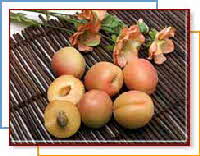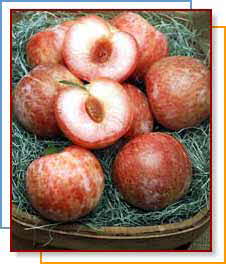Home | FOOD ARTICLES | Food Trivia | Today_in_Food_History | Food_History_Timeline | Recipes | Cooking_Tips | Food_Videos | Food_Quotes | Who’s_Who | Culinary_Schools_&_Tours | Food_Trivia_Quizzes | Food_Poems | Free_Magazines | Food_Festivals_and_Events
Food Articles, News & Features Section
FREE Magazines
and other Publications
Free Professional and Technical Research, White Papers, Case Studies, Magazines, and eBooks
PLUOTS AND APRIUMS
*Pluot® and Aprium® are registered trademarks of Zaiger Genetics, Modesto, California
**Photos from Melissa's www.melissas.com
Pluots are complex hybrid fruits that are part plum and part apricot in heritage. These fruits were originally invented in the late 20th century by Floyd Zaiger and are now grown in parts of Washington and California. Pluots have a majority of plum parentage and therefore, have smooth skin like plums. Some varieties of pluots are sometimes called interspecific plums, or dinosaur eggs.
The pluot is often confused with the aprium which is another plum and apricot hybrid with mostly apricot heritage. Like apricots, apriums have slightly fuzzy skin. Pluots and apriums are known for their sweetness and flavor; the sugar content of these fruits is much higher than that of a plum or apricot alone.

Availability
Pluot and aprium season stretches from May to September. Pluots can be found mostly in milder climates.
Selection
Pluots and apriums should be plump and firm. Avoid pluots that are green, blemished, or have broken skin.
Storage
Pluots and apriums should be ripened at room temperature and then refrigerated. Pluots can be ripened in a brown paper bag at room temperature.
Preparation
Fruit should be washed well and dried before consumption. To remove pit, cut the fruit in half. Pluots and apriums can be eaten fresh or cooked.

Varieties
Approximately 20 varieties of pluots have been developed and bred by Zaiger Genetics. Each variety contains a different percentage of plum and apricot parentage. These varieties vary in size, skin color, and flesh color. The skin can be solid, striped, or speckled and skin colors range from yellow-green to black. Pluot flesh ranges from white to red in color.
There is only one variety of aprium currently on the market. The Honey Rich interspecific is bright orange and has bright orange flesh.
Pluot varieties include:
Candy Stripe: medium, pink-yellow striped, with very sweet and juicy flesh.
Cherry: small, bright red skin with white flesh.
Dapple Dandy: large sweet with pale green to yellow, red-spotted skin, red or pink juicy flesh.
Flavorella: round, medium-sized, golden-yellow, with sweet and juicy flesh.
Flavor Heart: very large, black with a heart shape, and yellow flesh.
Flavor King: very sweet, medium or large, with red-purple skin and red flesh.
Flavorosa: very sweet or tart, medium-sized, flat round dark-purple fruit with red flesh.
Flavor Prince: large round and purple, with red flesh
Flavor Rich: medium-sweet, large black round fruit with orange flesh.
Flavor Supreme: medium or large, greenish purple skin, juicy red flesh.
Flavor Queen: large light-green to yellow, very juicy
Red Ray: medium, bright red with dense, sweet orange flesh.
- Make Pluots and Apriums Part of Your 5 A Day Plan
- Use pluots and apriums in sauces to pour over waffles or pancakes.
- Substitute pluots for plums in recipes.
- Use pluots and apriums as a topping for yogurt or as dessert.
- Add sliced pluots or apriums to your next salad.
- Add pluots or apriums to your favorite cereal.
- Make a pluot of aprium crisp for dessert.
- Serve pluots over low calorie ice cream.
RELATED ARTICLES
Please feel free to link to any pages of FoodReference.com from your website.
For permission to use any of this content please E-mail: james@foodreference.com
All contents are copyright © 1990 - 2025 James T. Ehler and www.FoodReference.com unless otherwise noted. All rights reserved.
You may copy and use portions of this website for non-commercial, personal use only.
Any other use of these materials without prior written authorization is not very nice and violates the copyright.
Please take the time to request permission.


